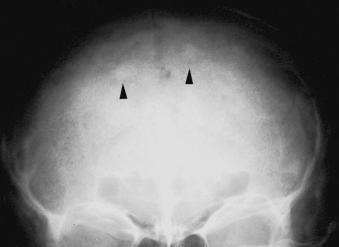Physical Address
304 North Cardinal St.
Dorchester Center, MA 02124
Tuberous sclerosis (Bourneville syndrome, Bourneville-Pringle syndrome, Bourneville-Brissaud disease, Pringle disease, phakomatosis, epiloia) is a neurocutaneous syndrome that is classically characterized by a clinical triad of epileptic seizures, mental retardation, and adenoma sebaceum (dermal angiofibroma). Despite the classic triad, tuberous sclerosis can manifest in a wide variety of clinical, pathologic, and radiologic features, including the presence of hamartomas (benign neoplasms composed of cellular elements normally present in tissue) in multiple organ systems. These lesions may include renal angiomyolipomas, cerebral and paraventricular hamartomas, and cardiac rhabdomyomas. Various skin abnormalities, such as hypomelanotic macules, shagreen patches, and periungual fibromas may be noted, and pulmonary involvement may include lymphangioleiomyomatosis and the development of pneumothorax.
Two thirds of patients with tuberous sclerosis additionally present with musculoskeletal involvement, including sclerotic lesions in the calvaria ( Fig. 88-1 ), ribs, pelvis, vertebrae, and long bones, as well as bone lucencies in the phalanges of the hands and feet. There is also evidence of an association between tuberous sclerosis and fibrous dysplasia (disorder of progressive replacement of normal bone elements by fibrous tissue) and an association between tuberous sclerosis and congenital macrodactyly.

The etiology of tuberous sclerosis has been linked to mutations in two separate genes, TSC1 and TSC2 . The TSC1 gene, which maps to chromosome 9q34, encodes a protein termed hamartin , which is widely expressed in normal tissues. Although the precise function of hamartin in normal tissues is unknown, it forms a complex with the tuberin protein that is encoded by the TSC2 gene, and the complex is thought to function in part as a negative regulator of the cell cycle. Several different types of TSC1 mutations have been identified, most of which result in a truncated protein with loss of function. The TSC2 gene, which maps to chromosome 16p13.3, is ubiquitously expressed in all adult normal tissues and encodes the tuberin protein. Although the exact function of the tuberin protein is unknown, it appears to participate in normal brain development and in withdrawal of the normal cardiomyocyte from the cell cycle during terminal differentiation.
Tuberous sclerosis is a hereditary autosomal dominant disorder with an incidence of 1 in 10,000 live births but is sporadic and without family history in 50% to 84% of cases.
Become a Clinical Tree membership for Full access and enjoy Unlimited articles
If you are a member. Log in here